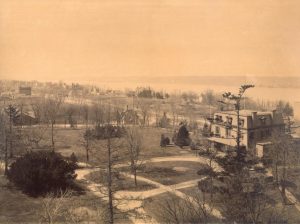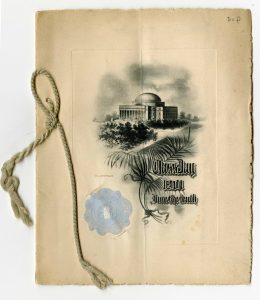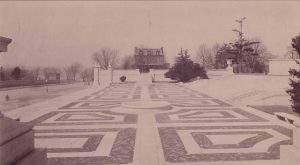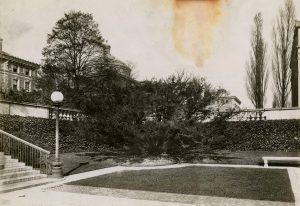Senior Class gifts have evolved significantly over the years. In the early days of Columbia on Morningside Heights, the Senior Class ended their Class Day with the presentation of the class gift: the planting of a yew tree and a speech given by a Yew Tree Orator chosen by the class. Why would students give the University a yew tree? And where are all these yew trees today?
In 1801 Dr. David Hosack, a member of the Columbia medical faculty, purchased 20 acres from the City of New-York to develop a research garden. He named it the Elgin Botanical Garden. (The Garden was located between 47th and 50th Street and Fifth and Sixth Avenue, what we now know as Rockefeller Center.) After growing and maintaining the garden for a number of years, the costs had become prohibitive for one person and Dr. Hosack persuaded the State to purchase the property in 1811. A few years later, in 1814, the State placed the Garden under the charge of the Trustees of Columbia University.

In 1819, the Columbia trustees appointed a Committee on Disposition of the Botanical Garden to figure out what to do with the plants in Dr. Hosack’s former garden. The Committee made a list of the plants, which were then offered to other colleges in the state. They also offered the Governors of the New-York Hospital Society “ornamental plants, trees and shrubs as may be removed without injury to the place.” In their new homes in city hospital grounds, the plants were to “contribute to the embellishment of the place and the amusement of the patients.” As part of this plan, in the 1820s, two yew trees from the former Elgin Botanical Garden were replanted at the Bloomingdale Asylum. These majestic trees, which had been imported from England, stood proudly on the lawn in front of the Asylum’s main hospital building on what would later be 116th Street.
When Columbia bought the Bloomingdale Asylum property in 1892, Dr. Hosack’s yew trees were reunited with Columbia and they were given pride of place in the new campus design. The trees were very carefully moved and replanted by the steps leading to the first campus building, what we now know as Low Library. Serving as anchors to the South Court or Low Plaza, these ancient trees stood as monuments of Columbia’s early history and the legacy of David Hosack.

The yew trees were such a campus symbol that in 1898 Superintendent Edward A. Darling suggested that the senior class plant a yew tree at graduation instead of an ivy vine. He argued that a yew tree would “be a more lasting monument and better suit the surroundings of Columbia, which has in these fine old trees something entirely different from the decorations of other colleges.” For a few years, Columbia College senior classes would elect a Yew Tree Orator, who would deliver a speech presenting a new yew tree at the end of Class Day. However, the tradition was short-lived as not a single yew tree planted on Class Days from 1898 to 1905 survived. In light of this trend, the Class of 1906 planted ivy instead. In fact, the Class of 1899 arranged to plant a replacement for their Class Day yew tree, not once, not twice, but three times by 1926, all unsuccessfully.
And what about Dr. Hosack’s original yew trees? Many reasons are given for the trees’ demise. Some blamed the heat and sun glare from the brick pavement around the trees. The plaza tiles were later removed and ditches were added in 1906 but the trees did not improve. Others thought that only Spencer, the Asylum’s groundskeeper, knew how to look after the trees properly. Once Spencer and his trusty dog Dusty retired in 1909, the trees continued to decline. In a final attempt to rescue the trees, they were replanted once more in 1916 but ultimately did not survive.
At the University Archives, we have a few pieces of the trees preserved. For a while, a cross cut of the yew trees was used as the gavel block for the meetings of the Trustees. The plaque on it reads: “From one of the old yew trees which grew in the Hosack Botanical Garden from 1806 until removed in 1819 to the site now occupied by the South Court where they survived until 1916.”

